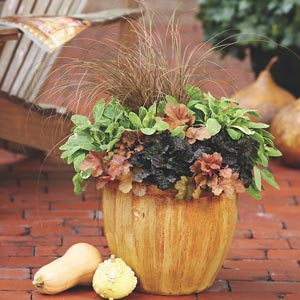 On a protected porch, a large white pumpkin demands attention among mini gourds. Variegated vinca vine adds a bit of green, and strands of faux leaves swirl the oriental-themed urn. Spanish moss fills in any gaps.
On a protected porch, a large white pumpkin demands attention among mini gourds. Variegated vinca vine adds a bit of green, and strands of faux leaves swirl the oriental-themed urn. Spanish moss fills in any gaps.
© Jo Ellen Meyers Sharp
If you are tired of mums as the primary flower for fall containers, take heart. There are a lot more plants with flowers or fantastic foliage that can beautify the season and carry your pots into winter.
 A magical blue pumpkin shares space with mini blue ornamental cabbages. Variegated ivy from the summer arrangement spills over the sides. A swatch of blue ornamental switchgrass (Panicum virgatum) cut from the garden stands stall in back. The combo compliments the stonewall.
A magical blue pumpkin shares space with mini blue ornamental cabbages. Variegated ivy from the summer arrangement spills over the sides. A swatch of blue ornamental switchgrass (Panicum virgatum) cut from the garden stands stall in back. The combo compliments the stonewall.
© Jo Ellen Meyers Sharp
Garden centers restock this time of year with annuals that tolerate cool temperatures, maybe even a frost or two and keep on blooming. Look for calibrachoa (million bells), snapdragon, diascia, nemesia, osteospermum (sometimes called African daisy or Cape daisy), pansy and viola. Even petunias can take a chill or two.
 A planter of perennials in fall colors includes Black Scallop bugleweed, Icterina golden leaf sage (Salvia officinalis), Peach Melba coral bell and a tuft of Toffee Twist sedge. A butternut squash and warty gourd rest at the base of the fall-hued pot.
A planter of perennials in fall colors includes Black Scallop bugleweed, Icterina golden leaf sage (Salvia officinalis), Peach Melba coral bell and a tuft of Toffee Twist sedge. A butternut squash and warty gourd rest at the base of the fall-hued pot.
© Proven Winners
These annuals can be mixed with other popular fall-oriented plants, such as mini, ornamental cabbage and kale, colorful Swiss chard, lovely pumpkin and gnarly gourds. It’s fine to tuck a few mums in for additional color. For containers of mixed plants, look for mums in 4-inch pots rather than the 6- or 8-inch size. The smaller mums are easier to work into pots, window boxes and other containers.
Here are some more great tips:
- Don’t feel like you have to replant all of your summer pots for fall. Pick two or three in key areas to dress for the season, such as the porch, the deck, by a garage door or as a focal point in a garden bed.
- Don’t fret too much about whether plants need sun or shade. The sun is less intense in fall and with fewer leaves on trees and shrub, the light should be just right.
- Work in a strand or two of fall-colored faux leaves. Some could drape over the side of the pot for bit of interest.
- For added texture, stick in a sedge, or two or an annual ornamental grass in the pot.
- Snip a few branches from shrubs that have fruit or colorful leaves, such as viburnum and beautyberry.
- Scour the landscape for dried plants, such as ornamental grass seed heads and rose hips. Dried hydrangeas also work well in fall pots.
- For a dramatic flair, mix pumpkin with ornamental cabbage and kale to create a specific color scheme.
- A lot of gardeners use colorful ornamental peppers in fall pots. These work well when the season is mild, but remember that peppers are more susceptible to freeze damage.
- To enhance the blooms, provide flowering annuals with periodic applications of all-purpose plant food.
By Jo Ellen Meyers Sharp